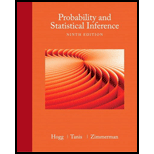
Let X equal the thickness of spearmint gum manufactured for vending machines. Assume that the distribution of X is
The target thickness is 7.5 hundredths of an inch. We shall test the null hypothesis
(a) Define the test statistic and critical region for an
(b) Calculate the value of the test statistic and state your decision clearly, using the following ii = 10 thicknesses in hundredths of an inch for pieces of gum that were selected randomly from the production line:
7.65 7.60 7.65 7.70 7.55
7.55 7.40 7.40 7.50 7.50
(c) Is
Want to see the full answer?
Check out a sample textbook solution
Chapter 8 Solutions
Probability and Statistical Inference (9th Edition)
- In a survey, the planning value for the population proportion is p 0.25. How large a sample should be taken to provide a 95% confidence interval with a margin of error of 0.03? Round your answer up to the next whole number. 800 {arrow_forwardFind the LaPla se trnsofrom of a) chi-square Distribution. b) Normal Distribution. C) Gamma Distribution. prove that Binomial (n, 2) Poisson (2) *********************arrow_forward-xx0. B2 If Xfx(x) find the MGF in the case that fx(x) = - 1 28 exp{-|x − a\/ẞ}, Use the MGF to compute E(X) and Var(X).arrow_forward
- B3 Consider X ~ Bern(p) (a) Find Mx(t), the moment generating function of X. iid (b) If X1,..., Xn Bern(p), find the MGF, say My (t) of n Y = ΣΧ (c) Using the fact that i=1 n lim (1 (1+2)"= N→X = e² find limn→∞ My (t) in the case that p satisfies limn→∞ np = λ, say. (d) State the distribution of Y in the case that n is not large, and the distribution of Y in the limiting case described in the question.arrow_forwardB1 The density of the x2 distribution is given in the notes as 1 F(§)2/2 (x)=()2/21 x/2-1/2, if x > 0, and e where I(t)=√xt-¹e dx is the gamma function. otherwise, Find the point at which o(a) has its maximum, i.e. find arg max, o, (x)arrow_forward18. Let X be normally distributed with mean μ = 2,500 and stan- dard deviation σ = 800. a. Find x such that P(X ≤ x) = 0.9382. b. Find x such that P(X>x) = 0.025. ة نفـة C. Find x such that P(2500arrow_forward17. Let X be normally distributed with mean μ = 2.5 and standard deviation σ = 2. a. Find P(X> 7.6). b. Find P(7.4≤x≤ 10.6). 21 C. Find x such that P(X>x) = 0.025. d. Find x such that P(X ≤x≤2.5)= 0.4943. and stan-arrow_forward16. Let X be normally distributed with mean μ = 120 and standard deviation σ = 20. a. Find P(X86). b. Find P(80 ≤x≤ 100). ة ن فـ d. Find x such that P(X ≤x) = 0.40. Find x such that P(X>x) = 0.90.arrow_forwardhe following contingency table details the sex and age distribution of the patients currently registered at a family physician's medical practice. If the doctor sees 17 patients per day, use the binomial formula and the information contained in the table to answer the question: SEX AGE Under 20 20-39 40-59 60-79 80 or over TOTAL Male 5.6% 12.8% 18.4% 14.4% 3.6% 54.8% Female 2.8% 9.6% 13.2% 10.4% 9.2% 45.2% TOTAL 8.4% 22.4% 31.6% 24.8% 12.8% 100.0% if the doctor sees 6 male patients in a day, what is the probability that at most half of them are aged under 39?arrow_forwardPam, Rob and Sam get a cake that is one-third chocolate, one-third vanilla, and one-third strawberry as shown below. They wish to fairly divide the cake using the lone chooser method. Pam likes strawberry twice as much as chocolate or vanilla. Rob only likes chocolate. Sam, the chooser, likes vanilla and strawberry twice as much as chocolate. In the first division, Pam cuts the strawberry piece off and lets Rob choose his favorite piece. Based on that, Rob chooses the chocolate and vanilla parts. Note: All cuts made to the cake shown below are vertical.What pieces would Sam choose based on the Pam and Rob's second division of their own pieces?arrow_forwardPlease plot graphs to represent the functionsarrow_forwardEXAMPLE 6.2 In Example 5.4, we considered the random variables Y₁ (the proportional amount of gasoline stocked at the beginning of a week) and Y2 (the proportional amount of gasoline sold during the week). The joint density function of Y₁ and Y2 is given by 3y1, 0 ≤ y2 yı≤ 1, f(y1, y2) = 0, elsewhere. Find the probability density function for U = Y₁ - Y₂, the proportional amount of gasoline remaining at the end of the week. Use the density function of U to find E(U).arrow_forwardarrow_back_iosSEE MORE QUESTIONSarrow_forward_ios
 Glencoe Algebra 1, Student Edition, 9780079039897...AlgebraISBN:9780079039897Author:CarterPublisher:McGraw Hill
Glencoe Algebra 1, Student Edition, 9780079039897...AlgebraISBN:9780079039897Author:CarterPublisher:McGraw Hill
